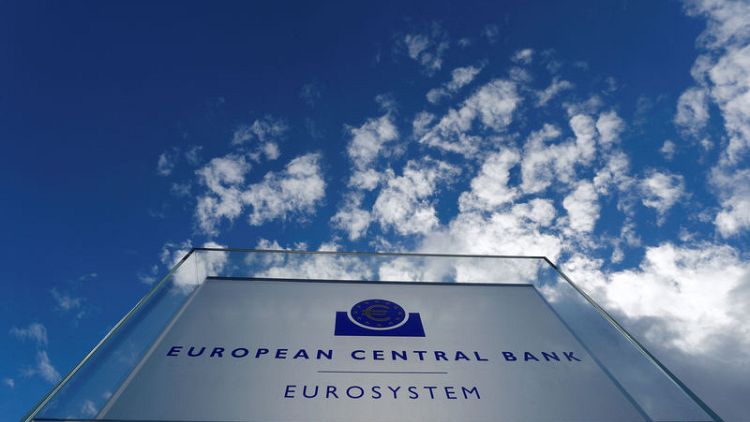By Dhara Ranasinghe and Ritvik Carvalho
LONDON (Reuters) - With euro zone growth faltering again, markets are debating what else the European Central Bank can do to shore up the economy.
After pushing borrowing costs to record lows and taking 2.6 trillion euros (£2.2 trillion) worth of bonds out of the market to revive inflation, its toolkit is limited.
But as outlined below, options do exist.
1/CHANGE GUIDANCE, OFFER TLTROs
Changing guidance on its plans for interest rates is widely seen as an easy first step.
In March, the ECB pushed out the timing of its first post-crisis rate hike to 2020 at the earliest.
This is expected to be delayed further, but doing so could have a limited impact as markets no longer expect a rate hike over the next two years. In fact, rate cut bets have been building.
So, a change in guidance would likely be combined with a very generous package of cheap multi-year loans - or targeted longer-term refinancing operations (TLTRO) - aimed at banks.
The ECB is set to launch a fresh TLTRO in September, but as details are not yet finalised it has time to assess whether more generous terms are needed.
(Graphic - Will the ECB's next move be a rate cut?, https://tmsnrt.rs/2ElFVza)
2/ CUT RATES, TIER RATES
The ECB is studying whether to grant relief to banks from some of the burden of its -0.4% deposit rate, worried that weak bank profitability could impair transmission of monetary policy.
For markets, tiered rates are only likely as part of a bigger easing that involves rate cuts.
Economists say a cut would require significantly weaker economic conditions, while one source told Reuters this was nowhere near to being discussed by the ECB.
But don't rule it out: New Zealand and Iceland cut rates in May, Australia may follow in June and markets anticipate a U.S. rate cut this year.
For an interactive version of this chart: https://tmsnrt.rs/2EdOcoU
(Graphic - Excess reserves at the ECB have grown dramatically, click here https://tmsnrt.rs/2EeKefz)
3/BRING BACK QE!
The ECB says it is will use all tools available to boost growth and inflation, including resuming the asset-purchase scheme it ended just five months ago.
Capital Economics expects QE to return next year and ABN AMRO believes any new stimulus is likely to take this form.
But first, the ECB would need to raise the limit on how much sovereign debt it can hold from a single issuer, given it was already approaching the current 33% limit when QE ended.
That ceiling was introduced to ensure the ECB did not have a deciding vote in case of a debt restructuring, and changing it could expose the ECB to legal challenges.
For an interactive version of the chart below: https://tmsnrt.rs/2EgAulf
"Although raising the limit would likely be an uncomfortable situation for the ECB, it would be willing to do this in our view given the lack of other alternatives," said ABN AMRO's head of financial market research Nick Kounis.
(Graphic - ECB PSPP, click here https://tmsnrt.rs/2EfklfI)
4/BUY STOCKS, BONDS, SOURED LOANS
With government bonds getting scarce, the ECB added corporate debt to QE asset purchases in 2016. A new QE round could include shares.
Switzerland's central bank buys stocks to diversify its currency reserves and the Bank of Japan buys equity exchange traded funds (ETFs) as part of its QE.
ECB Vice President Luis de Guindos said in April the ECB had not discussed buying stocks, and many question the effectiveness of equity purchases.
"It's doable and sensible but it would be complicated," said Marchel Alexandrovich, European financial economist at Jefferies. The European stock market is relatively small and buying stocks could leave the ECB open to criticism that it is picking companies that don't apply best business practices, he said.
Buying bank bonds would be a game changer, said TS Lombard senior economist Shweta Singh. "This would release a lot of assets for the ECB to buy but it is next to impossible, as it would complicate the ECB's role as bank supervisor," she said.
Buying banks' non-performing loans would also have a more powerful impact than buying equities but conflicts with the ECB's supervisory role.
(Graphic - Size of major world equity markets, https://tmsnrt.rs/2WlhJHn)
5/YIELD CURVE CONTROL
One way to add more economic stimulus could be to target explicit levels for long-term interest rates.
The BOJ has targeted long-term yields around zero since 2016, and the idea is gaining traction. Federal Reserve official Lael Brainard has said she wanted to explore whether the Fed, in a future downturn, should consider this step.
It would be more complicated for the ECB, said Mohammed Kazmi, portfolio manager for UBP in Geneva. "The natural answer is to target Germany because the other countries' bonds are priced against Germany," he said.
But German bonds are in short supply. The ECB could change its capital key rule, where it buys bonds relative to a member state's contribution to the ECB working capital. That would allow it to target another bond market though this in turn would leave it open to charges of financing spending by weaker states.
(Graphic - Yield curve control: a leaf out of the BoJ's book?, https://tmsnrt.rs/2Wljl3V)
(Reporting by Dhara Ranasinghe; Graphics by Ritvik Carvalho; Additional reporting by Balazs Koranyi in Frankfurt; editing by John Stonestreet)



